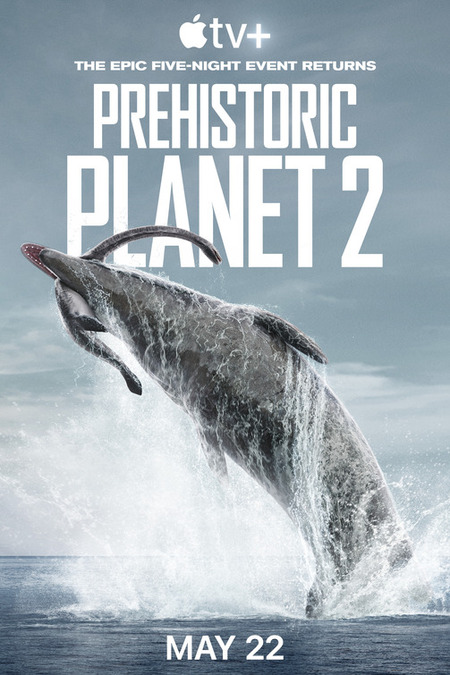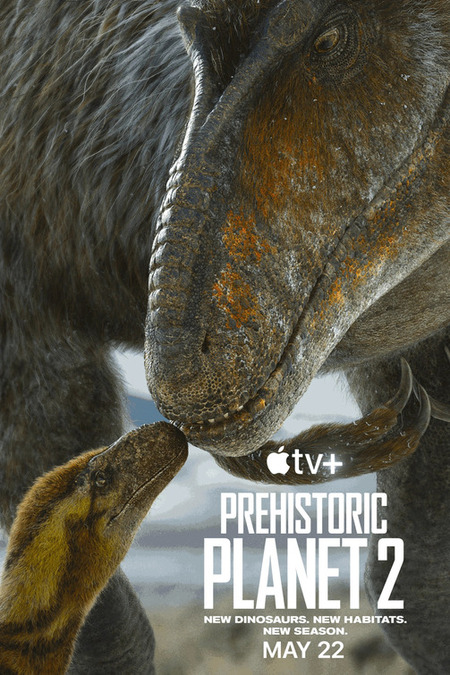(courtesy IMP awards)
Dinosaurs, and indeed any kind of prehistoric life, have long held a fascination for many people including this reviewer who, like many kids his age, loved playing ancient animal games with toys of T-rex, Stegosaurus and Triceratops.
Reading about the latest discoveries and absorbing how weirdly wonderful millions of years ago was and is something that never ceases to fascinate, more so when it is presented as superlatively as Prehistoric Planet 2, the successor to the first season which debuted as a major documentary event last year on AppleTV+.
The series also has the added drawcard of some presentation elements and narration by Sir David Attenborough whose infectious love of the natural world and garrulous but hushed enthusiasm for talking about it shows no sign of slowing down even in the second half of his tenth decade alive.
His enthusiasm for the subject matter at hand is understandable with new discoveries such as the 2020 uncovering of an ancient mammal called Adalatherium reminding us of how much more we still have to learn and how brilliantly beguiling the natural world of some 66 million years ago was.
But it’s not simply the incorporation of the latest scientific discoveries that stamp Prehistoric Planet 2 as something special.
The thing that strikes you first and which remains with you through the five 40 or so-minute episodes, which include a roughly half hour documentary and about 10 minutes with scientific experts discussing a key aspect of that particular episode, is how things that suddenly seemed fascinating but remote suddenly feel like they are alive and happening now.
That’s a deliberate result of the approach to making the series as executive producer Mike Gunton explains to Cinemablend.
‘As you would in any natural history. You’re trying to represent a world. And of course if you went today and filmed, you wouldn’t just do mammals. You wouldn’t just do the superstars, you also do birds, and reptiles, and fish, and insects, and plants. So we’re game in replicating that in Prehistoric Planet. Trying to paint a portrait of what it would be like to take the ultimate safari, if you were able to 66 million years ago, what would you see? Well, you’d see all this, and you’d want to see all this. You want to see the range and the oddities, but you also want to see the box office superstars. You definitely get to see a T-Rex on this safari, but some other stuff too.’
(courtesy IMP Awards)
It’s this approach to make the ancient feel as immediate and vitally alive as any documentary about modern wildlife and landscapes that makes Prehistoric Planet 2 such a compelling watch.
Sure, you get to see some utterly fascinating animals on land and sea such as the gigantic sea-dwelling predator Mosasaur, the feathered Velociraptors and airborne giant pterosaur Quetzalcoatlus (who’d happily take on T-Rex for the rights to eat the body of a scavenged plant eater behemoth, Alamosaurus), and lesser known dinosaurs such as the Indian subcontinent’s Rajasaurus and bony-domed skulled Pachycephalosaurus, but what strikes you the most is how real they seem.
Attenborough narrates as if they are living and breathing now, and while spell is broken somewhat by the interviews at the end with prehistoric wildlife experts, you finish the five episodes of the current season, feeling as if you could walk outside and see these animals in action.
While Jurassic Park and other movies and shows have tried the approach of bringing dinosaurs into the here & now, they never really captured the immediacy of modern documentaries but Prehistoric Planet 2 manages it beautifully, describing the lives of a vast menagerie of ancient animals as if they were out in the wild now.
It’s a thrilling way to make the ancient feel tactile and now and it grants these extraordinary animals the gift of not just being fossilised remains in a museum or the subject of a paper in a scientific journal, but of creatures that were vitally part of their ecosystem back in the day.
So it is that we get to see Triceratops males competing for breeding partners through rutting, using their giant horns and head shields to maximum effect, or desert-dwelling Tarchia (a member of the tank-like Ankylosaur family) and Mortuneria, a cold water-dwelling plesiosaur schooling its young on how best to survive in the icy realms of the poles.
With parallels to animals living today, the creatures of the prehistoric world cease to be just museum specimens and become vitally connected to life on earth today, making them even more fascinating than they already were.
Prehistoric Planet 2 is a gem of a series, replete as it is with stellar writing, expert narration, CGI of the highest quality and a love for the ancient natural world, all of these elements coming together to make dinosaurs, pterosaurs and mosasaurs and a host of other species feel as vital and real as elephants and giraffes today, and turning dusty museum exhibits into members of the natural world that were vivaciously alive way back in the day and remain every bit as excitingly alive now, at least in our documentary-enhanced imaginations.
Some clips from Prehistoric Planet season 2 …
Mosasaurs
Pterosaurs

